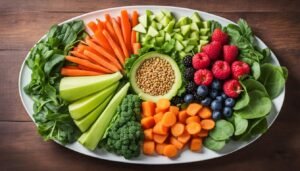Get our FREE E-Book HERE - 120 TIPS for Losing Weight & Bonus Tips for Postpartum Weight Loss & Dad’s Postpartum Experience
Everything you wanted to know about the DASH Diet

The DASH (Dietary Approaches to Stop Hypertension) diet is a dietary plan designed to help lower blood pressure and improve overall heart health. It emphasizes a balanced approach to eating that includes a variety of nutrient-rich foods. In this comprehensive guide, we will explore the principles of the DASH diet, its health benefits, and the scientific evidence supporting its effectiveness.

Introduction to the DASH Diet
The DASH diet was developed in the early 1990s by the National Heart, Lung, and Blood Institute (NHLBI) as part of a study aimed at finding ways to lower blood pressure without medication. It has since become a widely recognized and recommended dietary plan for managing hypertension and promoting heart health.
It focuses on reducing sodium (salt) intake while encouraging the consumption of foods rich in key nutrients such as potassium, calcium, magnesium, and fiber. By emphasizing whole foods and limiting processed and high-sodium options, the DASH diet aims to reduce blood pressure, lower the risk of heart disease, and improve overall well-being.
Key Principles of the DASH Diet
The DASH diet is based on several key principles that promote heart-healthy eating:
- Sodium Reduction: One of the central tenets of this diet is the reduction of sodium intake. Excessive sodium consumption is a known risk factor for high blood pressure (hypertension). The DASH diet recommends limiting sodium to 2,300 milligrams per day, with an ideal target of 1,500 milligrams for some individuals, especially those with hypertension.
- Balanced Nutrient Intake: The DASH diet encourages a balanced intake of essential nutrients, including carbohydrates, protein, and healthy fats. It emphasizes the quality of these nutrients, favoring whole foods over processed options.
- Increased Potassium: Potassium-rich foods, such as fruits and vegetables, are emphasized in the DASH diet. Potassium helps counteract the effects of sodium and can help lower blood pressure.
- Magnesium and Calcium: Foods rich in magnesium and calcium, like dairy products, nuts, seeds, and leafy greens, are encouraged as they also play a role in blood pressure regulation.
- Lean Protein: The DASH diet recommends 2 or fewer servings of lean meats or poultry per day. Skinless poultry, fish, and lean cuts of beef or pork are good choices.
- Nuts, Seeds, and Legumes: These are included as part of a healthy eating pattern in the DASH diet. Almonds, walnuts, chia seeds, and beans like lentils and chickpeas are excellent options.
- Dairy: The diet includes 2-3 servings of low-fat or fat-free dairy products daily, such as milk, yogurt, or cheese, to provide calcium and protein.
- Fats and Oils: While fat intake is moderated, the DASH diet promotes the consumption of healthy fats like olive oil, avocados, and nuts.
- Fruits and Vegetables: Aim for 4-5 servings of fruits and 4-5 servings of vegetables daily. A variety of colorful options should be included to provide essential vitamins, minerals, and antioxidants.
- Whole Grains: Incorporate 6-8 servings of whole grains daily. These can include whole wheat bread, brown rice, quinoa, and oats, which offer fiber and nutrients.
- Limit Sweets and Added Sugars: Sweets and added sugars should be limited to 5 servings or less per week. Choose dark chocolate or small portions of desserts when indulging.
Scientific Evidence Supporting the DASH Diet
The DASH diet’s effectiveness in lowering blood pressure and improving heart health has been extensively studied and supported by scientific research. Here are key studies that highlight its benefits:
- Original DASH Study (1997): The landmark study that introduced the DASH diet demonstrated its significant impact on blood pressure reduction. Published in The New England Journal of Medicine, the study found that participants who followed the DASH diet experienced a substantial decrease in blood pressure, especially those with hypertension. This study provided the foundation for the DASH diet’s recommendations.
- DASH-Sodium Study (2001): This study, also published in The New England Journal of Medicine, investigated the effects of different levels of sodium intake on blood pressure. It confirmed that reducing sodium while following this diet led to even greater reductions in blood pressure. It emphasized the importance of limiting sodium to lower blood pressure effectively.
- DASH Diet and Weight Loss (2008): A study published in the Archives of Internal Medicine examined the DASH diet’s impact on weight loss and found that it can be effective for weight management while offering cardiovascular benefits. Participants on the DASH diet lost weight and experienced improved blood pressure and lipid profiles.
- Long-Term Cardiovascular Health (2017): Research published in the Journal of the American College of Cardiology evaluated the long-term effects of the DASH diet on cardiovascular health. It found that adherence to the DASH diet was associated with a lower risk of heart failure and improved overall cardiovascular health.
- DASH Diet and Stroke Prevention (2020): A study published in the journal Stroke explored the relationship between the DASH diet and stroke prevention. It found that adherence to the DASH diet was associated with a reduced risk of stroke, highlighting its potential role in stroke prevention.
These studies collectively demonstrate the DASH diet’s effectiveness in reducing blood pressure, improving heart health, and preventing cardiovascular diseases. Its evidence-based approach to nutrition makes it a valuable dietary plan for individuals looking to manage hypertension and promote overall well-being.
Implementing the DASH Diet: Practical Tips
Adopting the DASH diet can be a practical and sustainable way to improve heart health. Here are some practical tips to help you implement the DASH diet in your daily life:
- Read Food Labels: Pay close attention to food labels to monitor sodium content. Look for low-sodium or no-salt-added options when shopping for packaged foods.
- Cook at Home: Preparing meals at home allows you to have better control over ingredients and portion sizes. Experiment with DASH-friendly recipes.
- Limit Processed Foods: Processed and packaged foods often contain hidden salt and added sugars. Minimize their consumption and opt for fresh, whole foods whenever possible.
- Stay Hydrated: Adequate hydration is essential for blood pressure regulation. Drink plenty of water throughout the day to support overall health.
- Monitor Your Progress: Keep track of your blood pressure and consult with a healthcare professional for guidance on how the DASH diet is affecting your health. Regular check-ups are important for tracking improvements.
- Be Patient: Changes in blood pressure may take time. Consistency with the DASH diet is key to seeing positive results. Aim for a gradual, sustainable transition to this eating pattern.
- Seek Professional Guidance: If you have specific health concerns, dietary restrictions, or unique nutritional needs, consider consulting a registered dietitian or healthcare provider for personalized guidance and meal planning.
Sample DASH Diet Meal Plan
Here’s a sample meal plan for a day on the DASH diet:
Breakfast:
- Oatmeal made with rolled oats, topped with fresh berries and a sprinkle of chopped nuts.
- A serving of low-fat yogurt.
- A glass of orange juice.
Lunch:
- A mixed salad with spinach, cherry tomatoes, cucumbers, and grilled chicken breast.
- A whole-grain roll or a small portion of brown rice.
- A piece of fruit, like an apple or a banana.
Snack:
- A small handful of baby carrots or cherry tomatoes.
- A serving of hummus for dipping.
Dinner:
- Baked salmon fillet with a squeeze of lemon.
- Steamed broccoli and quinoa.
- A side salad with mixed greens and vinaigrette dressing.
Snack (if needed):
- A piece of fruit or a small handful of nuts.
Conclusion
The DASH diet is a scientifically validated dietary plan that offers numerous health benefits, particularly for those looking to lower blood pressure and reduce the risk of cardiovascular diseases. Its emphasis on nutrient-rich foods, limited sodium intake, and balanced nutrition make it a valuable tool for improving heart health and overall well-being. While adopting the DASH diet may require some adjustments to your eating habits, the long-term benefits are well worth the effort. As always, it’s advisable to consult with a healthcare provider or registered dietitian before making significant dietary changes, especially if you have specific health concerns or conditions. With the right guidance and commitment, the DASH diet can help you achieve and maintain a healthier lifestyle.
The DASH (Dietary Approaches to Stop Hypertension) diet is a dietary plan designed to help lower blood pressure and improve overall heart health. It emphasizes a balanced approach to eating that includes a variety of nutrient-rich foods. In this comprehensive guide, we will explore the principles of the DASH diet, its health benefits, and the scientific evidence supporting its effectiveness.

Introduction to the DASH Diet
The DASH diet was developed in the early 1990s by the National Heart, Lung, and Blood Institute (NHLBI) as part of a study aimed at finding ways to lower blood pressure without medication. It has since become a widely recognized and recommended dietary plan for managing hypertension and promoting heart health.
The DASH diet focuses on reducing sodium (salt) intake while encouraging the consumption of foods rich in key nutrients such as potassium, calcium, magnesium, and fiber. By emphasizing whole foods and limiting processed and high-sodium options, the DASH diet aims to reduce blood pressure, lower the risk of heart disease, and improve overall well-being.
Key Principles of the DASH Diet
The DASH diet is based on several key principles that promote heart-healthy eating:
- Sodium Reduction: One of the central tenets of the DASH diet is the reduction of sodium intake. Excessive sodium consumption is a known risk factor for high blood pressure (hypertension). The DASH diet recommends limiting sodium to 2,300 milligrams per day, with an ideal target of 1,500 milligrams for some individuals, especially those with hypertension.
- Balanced Nutrient Intake: The DASH diet encourages a balanced intake of essential nutrients, including carbohydrates, protein, and healthy fats. It emphasizes the quality of these nutrients, favoring whole foods over processed options.
- Increased Potassium: Potassium-rich foods, such as fruits and vegetables, are emphasized in the DASH diet. Potassium helps counteract the effects of sodium and can help lower blood pressure.
- Magnesium and Calcium: Foods rich in magnesium and calcium, like dairy products, nuts, seeds, and leafy greens, are encouraged as they also play a role in blood pressure regulation.
- Lean Protein: The DASH diet recommends 2 or fewer servings of lean meats or poultry per day. Skinless poultry, fish, and lean cuts of beef or pork are good choices.
- Nuts, Seeds, and Legumes: These are included as part of a healthy eating pattern in the DASH diet. Almonds, walnuts, chia seeds, and beans like lentils and chickpeas are excellent options.
- Dairy: The diet includes 2-3 servings of low-fat or fat-free dairy products daily, such as milk, yogurt, or cheese, to provide calcium and protein.
- Fats and Oils: While fat intake is moderated, the DASH diet promotes the consumption of healthy fats like olive oil, avocados, and nuts.
- Fruits and Vegetables: Aim for 4-5 servings of fruits and 4-5 servings of vegetables daily. A variety of colorful options should be included to provide essential vitamins, minerals, and antioxidants.
- Whole Grains: Incorporate 6-8 servings of whole grains daily. These can include whole wheat bread, brown rice, quinoa, and oats, which offer fiber and nutrients.
- Limit Sweets and Added Sugars: Sweets and added sugars should be limited to 5 servings or less per week. Choose dark chocolate or small portions of desserts when indulging.
Scientific Evidence Supporting the DASH Diet
The DASH diet’s effectiveness in lowering blood pressure and improving heart health has been extensively studied and supported by scientific research. Here are key studies that highlight its benefits:
- Original DASH Study (1997): The landmark study that introduced the DASH diet demonstrated its significant impact on blood pressure reduction. Published in The New England Journal of Medicine, the study found that participants who followed the DASH diet experienced a substantial decrease in blood pressure, especially those with hypertension. This study provided the foundation for the DASH diet’s recommendations.
- DASH-Sodium Study (2001): This study, also published in The New England Journal of Medicine, investigated the effects of different levels of sodium intake on blood pressure. It confirmed that reducing sodium while following the DASH diet led to even greater reductions in blood pressure. It emphasized the importance of limiting sodium to lower blood pressure effectively.
- DASH Diet and Weight Loss (2008): A study published in the Archives of Internal Medicine examined the DASH diet’s impact on weight loss and found that it can be effective for weight management while offering cardiovascular benefits. Participants on the DASH diet lost weight and experienced improved blood pressure and lipid profiles.
- Long-Term Cardiovascular Health (2017): Research published in the Journal of the American College of Cardiology evaluated the long-term effects of the DASH diet on cardiovascular health. It found that adherence to the DASH diet was associated with a lower risk of heart failure and improved overall cardiovascular health.
- DASH Diet and Stroke Prevention (2020): A study published in the journal Stroke explored the relationship between the DASH diet and stroke prevention. It found that adherence to the DASH diet was associated with a reduced risk of stroke, highlighting its potential role in stroke prevention.
These studies collectively demonstrate the DASH diet’s effectiveness in reducing blood pressure, improving heart health, and preventing cardiovascular diseases. Its evidence-based approach to nutrition makes it a valuable dietary plan for individuals looking to manage hypertension and promote overall well-being.
Implementing the DASH Diet: Practical Tips
Adopting the DASH diet can be a practical and sustainable way to improve heart health. Here are some practical tips to help you implement the DASH diet in your daily life:
- Read Food Labels: Pay close attention to food labels to monitor sodium content. Look for low-sodium or no-salt-added options when shopping for packaged foods.
- Cook at Home: Preparing meals at home allows you to have better control over ingredients and portion sizes. Experiment with DASH-friendly recipes.
- Limit Processed Foods: Processed and packaged foods often contain hidden salt and added sugars. Minimize their consumption and opt for fresh, whole foods whenever possible.
- Stay Hydrated: Adequate hydration is essential for blood pressure regulation. Drink plenty of water throughout the day to support overall health.
- Monitor Your Progress: Keep track of your blood pressure and consult with a healthcare professional for guidance on how the DASH diet is affecting your health. Regular check-ups are important for tracking improvements.
- Be Patient: Changes in blood pressure may take time. Consistency with the DASH diet is key to seeing positive results. Aim for a gradual, sustainable transition to this eating pattern.
- Seek Professional Guidance: If you have specific health concerns, dietary restrictions, or unique nutritional needs, consider consulting a registered dietitian or healthcare provider for personalized guidance and meal planning.

Sample DASH Diet Meal Plan
Here’s a sample meal plan for a day on the DASH diet:
Breakfast:
- Oatmeal made with rolled oats, topped with fresh berries and a sprinkle of chopped nuts.
- A serving of low-fat yogurt.
- A glass of orange juice.
Lunch:
- A mixed salad with spinach, cherry tomatoes, cucumbers, and grilled chicken breast.
- A whole-grain roll or a small portion of brown rice.
- A piece of fruit, like an apple or a banana.
Snack:
- A small handful of baby carrots or cherry tomatoes.
- A serving of hummus for dipping.
Dinner:
- Baked salmon fillet with a squeeze of lemon.
- Steamed broccoli and quinoa.
- A side salad with mixed greens and vinaigrette dressing.
Snack (if needed):
- A piece of fruit or a small handful of nuts.

Conclusion
The DASH diet is a scientifically validated dietary plan that offers numerous health benefits, particularly for those looking to lower blood pressure and reduce the risk of cardiovascular diseases.
Its emphasis on nutrient-rich foods, limited sodium intake, and balanced nutrition make it a valuable tool for improving heart health and overall well-being. While adopting the DASH diet may require some adjustments to your eating habits, the long-term benefits are well worth the effort. As always, it’s advisable to consult with a healthcare provider or registered dietitian before making significant dietary changes, especially if you have specific health concerns or conditions. With the right guidance and commitment, the DASH diet can help you achieve and maintain a healthier lifestyle.
Don’t forget to check out our free tools, the BMI calculator and our Optimal Calories Calculator




